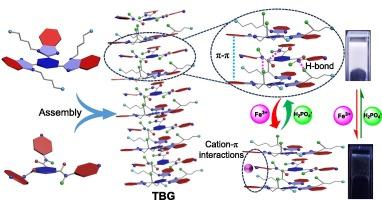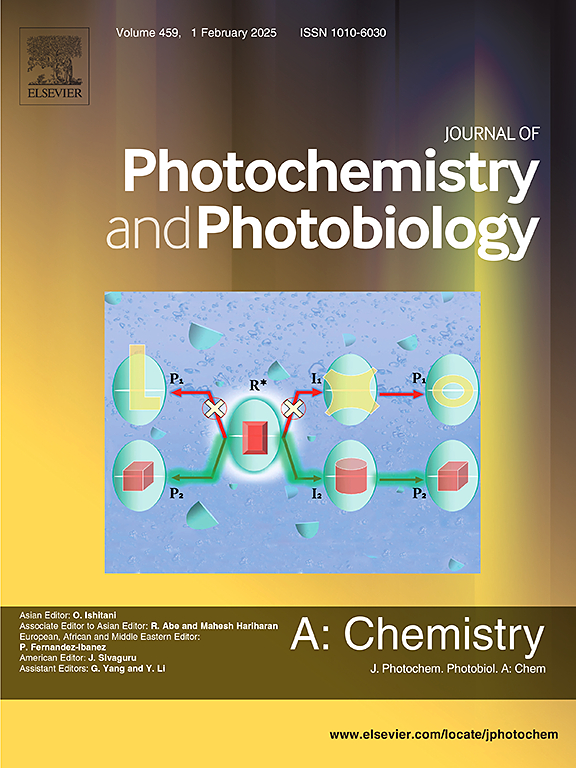Construction of white light “On-Off-On” supramolecular materials for relay detection of Fe3+ and H2PO4−
IF 4.1
3区 化学
Q2 CHEMISTRY, PHYSICAL
Journal of Photochemistry and Photobiology A-chemistry
Pub Date : 2024-09-24
DOI:10.1016/j.jphotochem.2024.116050
引用次数: 0
Abstract
White light materials are of great interest due to their wide potential applications in lighting devices, displays and probes. Herein, a novel bis-component white light-emitting supramolecular polymer gel TBG was facilely constructed from tripodal pyridine amides and tripodal imidazole by host–guest self-assembly process. Interestingly, the TBG exhibits strong aggregation-induced emission and can be used for highly efficient and sensitive fluorescence detection of ions (Fe3+ and H2PO4−) via the fluorescence “On-Off-On” pathway. The limits of lowest detection limits (LODs) for Fe3+ and H2PO4− were calculated to be 10.08 nM and 21.87 nM, respectively. Meanwhile, the xerogel of TBG could adsorb and separate Fe3+ from aqueous solutions, and the adsorption rate reached 99 %. In addition, a thin film based on the TBG could be used as a convenient test kit for the fluorescence detection of Fe3+ and H2PO4−.

构建用于接力检测 Fe3+ 和 H2PO4- 的白光 "开-关-开 "超分子材料
白光材料因其在照明设备、显示器和探针中的广泛应用而备受关注。在这里,一种新型双组分白光发光超分子聚合物凝胶 TBG 是由三元吡啶酰胺和三元咪唑通过主-客自组装过程轻松构建而成的。有趣的是,TBG 表现出强烈的聚集诱导发射,可通过荧光 "On-Off-On "途径用于高效、灵敏的离子(Fe3+ 和 H2PO4-)荧光检测。经计算,Fe3+ 和 H2PO4- 的最低检测限(LOD)分别为 10.08 nM 和 21.87 nM。同时,TBG 的 xerogel 能吸附并分离水溶液中的 Fe3+,吸附率达到 99%。此外,基于 TBG 的薄膜可用作荧光检测 Fe3+ 和 H2PO4- 的便捷试剂盒。
本文章由计算机程序翻译,如有差异,请以英文原文为准。
求助全文
约1分钟内获得全文
求助全文
来源期刊
CiteScore
7.90
自引率
7.00%
发文量
580
审稿时长
48 days
期刊介绍:
JPPA publishes the results of fundamental studies on all aspects of chemical phenomena induced by interactions between light and molecules/matter of all kinds.
All systems capable of being described at the molecular or integrated multimolecular level are appropriate for the journal. This includes all molecular chemical species as well as biomolecular, supramolecular, polymer and other macromolecular systems, as well as solid state photochemistry. In addition, the journal publishes studies of semiconductor and other photoactive organic and inorganic materials, photocatalysis (organic, inorganic, supramolecular and superconductor).
The scope includes condensed and gas phase photochemistry, as well as synchrotron radiation chemistry. A broad range of processes and techniques in photochemistry are covered such as light induced energy, electron and proton transfer; nonlinear photochemical behavior; mechanistic investigation of photochemical reactions and identification of the products of photochemical reactions; quantum yield determinations and measurements of rate constants for primary and secondary photochemical processes; steady-state and time-resolved emission, ultrafast spectroscopic methods, single molecule spectroscopy, time resolved X-ray diffraction, luminescence microscopy, and scattering spectroscopy applied to photochemistry. Papers in emerging and applied areas such as luminescent sensors, electroluminescence, solar energy conversion, atmospheric photochemistry, environmental remediation, and related photocatalytic chemistry are also welcome.

 求助内容:
求助内容: 应助结果提醒方式:
应助结果提醒方式:


